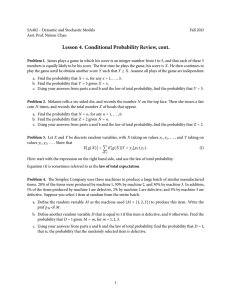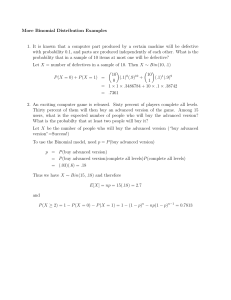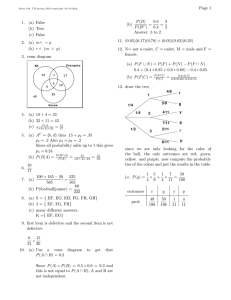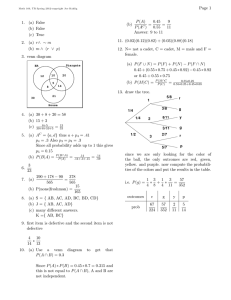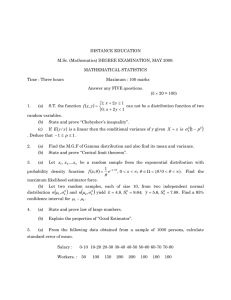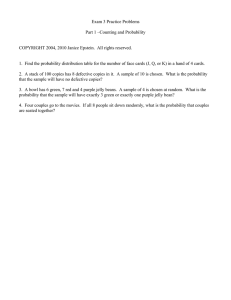THE NUM E F TE T
advertisement
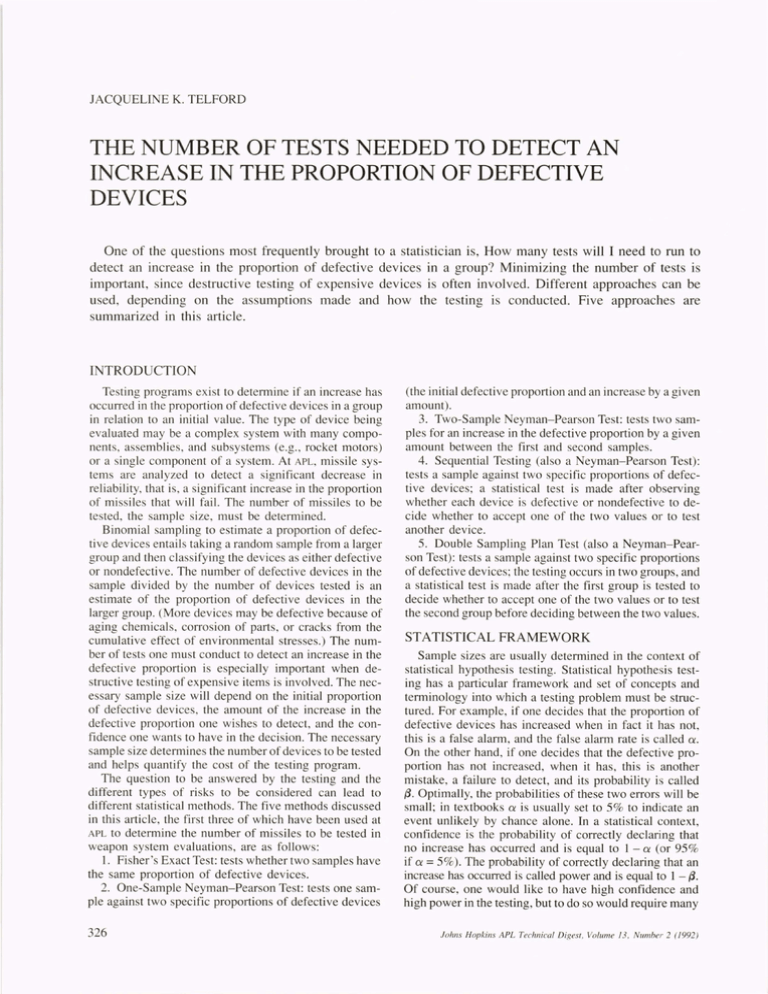
JACQUELINE K. TELFORD
THE NUMBER OF TESTS NEEDED TO DETECT AN
INCREASE IN THE PROPORTION OF DEFECTIVE
DEVICES
One of the questions most frequently brought to a statistician is, How many tests will I need to run to
detect an increase in the proportion of defective devices in a group? Minimizing the number of tests is
important, since destructive testing of expensive devices is often involved. Different approaches can be
used, depending on the assumptions made and how the testing is conducted. Five approaches are
summarized in this article.
INTRODUCTION
Testing program exist to detelmine if an increase has
occurred in the proportion of defective devices in a group
in relation to an initial value. The type of device being
evaluated may be a complex system with many components, assemblies, and subsystems (e.g., rocket motors)
or a single component of a system. At APl, missile systems are analyzed to detect a significant decrease in
reliability, that i ,a ignificant increase in the proportion
of missiles that will fail. The number of missiles to be
tested, the ample ize, must be determined.
Binomial ampling to estimate a proportion of defective devices entail taking a random sample from a larger
group and then cIa ifying the devices as either defective
or nondefective. The number of defective devices in the
sample divided by the number of devices tested is an
estimate of the proportion of defective devices in the
larger group. (More devices may be defective because of
aging chemical cOlTosion of parts or cracks from the
cumulative effect of environmental stresses.) The number of tests one mu t conduct to detect an increase in the
defective proportion is especially important when destructive testing of expensive items is involved. The necessary sample size will depend on the initial proportion
of defective devices, the amount of the increase in the
defective proportion one wishes to detect, and the confidence one want to have in the decision. The necessary
sample size determines the number of devices to be tested
and helps quantify the cost of the testing program.
The question to be answered by the testing and the
different types of risks to be considered can lead to
different statistical methods. The five methods discussed
in this article, the first three of which have been used at
APL to detetmine the number of missiles to be tested in
weapon system evaluations, are as follows:
1. Fisher 's Exact Te t: tests whether two amples have
the same proportion of defective device .
2. One-Sample Neyman-Pearson Test: tests one sample against two pecific proportions of defective devices
326
(the initial defective proportion and an increase by a given
amount).
3. Two-Sample Neyman-Pearson Test: tests two sample for an increase in the defective proportion by a given
amount between the first and second samples.
4. Sequential Testing (also a Neyman-Pearson Test):
te ts a sample against two specific proportions of defective devices; a statistical test is made after observing
whether each device is defective or nondefective to decide whether to accept one of the two values or to test
another device.
5. Double Sampling Plan Test (also a Neyman-Pearson Test): tests a sample against two specific proportions
of defective devices; the testing occurs in two groups, and
a statistical test is made after the first group is tested to
decide whether to accept one of the two values or to test
the second group before deciding between the two values.
STATISTICAL FRAMEWORK
Sample sizes are u ually detetmined in the context of
statistical hypothesis testing. Statistical hypothe is testing has a particular framework and set of concept and
terminology into which a testing problem must be structured. For example, if one decides that the proportion of
defective devices has increased when in fact it has not,
thi is a false alarm , and the false alatm rate i called Ci .
On the other hand, if one decides that the defective proportion has not increased, when it has, this is another
mistake, a failure to detect, and its probability i called
{J . Optimally, the probabilities of these two elTors will be
small; in textbooks Ci is usually set to 5% to indicate an
event unlikely by chance alone. In a statistical context,
confidence is the probability of correctly declaring that
no increase has OCCUlTed and is equal to 1 - Ci (or 95 %
if Ci = 5%). The probability of correctly declaring that an
increase has occurred is called power and is equal to 1 - {J.
Of course, one would like to have high confidence and
high power in the testing, but to do so would require many
J ohns Hopkins APL Techl1ical Digest, Volume 13, Number 2 (1992)
tests. Determining acceptable levels for ex and 13 is part
of the problem formulation. In this article, a 25 % false
alarm rate and a 75 % power will be used to limit the size
of the examples. The choices of ex and 13 should be
determined by the consequences of the two types of
errors. If one of the two is more serious than the other,
then the probability of that error should be set to a small
value and the other probability made considerably larger.
On the other hand, if one is equally concerned about the
two mistakes , then ex and 13 can be equal.
The probabilities ex and 13 are sometimes called producer's risk and consumer 's risk, respectively. Imagine
that a lot of identical components is received and in that
lot a certain maximum proportion of defective items is
acceptable. A sample of the lot is usually taken and tested
to decide whether to accept or reject the whole lot. An
incorrect decision to reject the lot is a false alarm and is
a risk to the producer of the items (ex). To decide incorrectly to keep the lot is a failure to detect the larger
proportion of defects and is a risk to the consumer of the
items (/3). If the acceptance criterion is very stringent
(very low consumer' risk, 13), many good lots will be
rejected, resulting in a high producer's ri sk (ex). If the
acceptance criterion is very loose (high consumer 's risk) ,
many bad lots will be accepted (low producer s risk).
Thus, a trade-off exist between the two types of risk.
We assume in this article that the testing can be
modeled by the binomial probability di tribution. The
assumptions for the binomial model are as follows:
1. The testing of each item will result in a classification of either defective or nondefective.
2. A constant proportion of defective items, denoted
by p, exists in the population of items tested.
The probability of a certain number of defective devices (x) in a sequence of tests (n) can be computed as
where
(xnJ -
n!
x!(n -x)!'
The number of tests required is also a function of the
initial proportion of defective devices and the amount of
increase one wishes to detect with the preestablished
amounts of ex and 13 risks. To illustrate the procedures and
computations used in testing, in this article the initial
proportion of defective items is 0.15, and the amount of
increase to be detected is 0.25. The assumption of no
change in the defective proportion is called the null hypothesis, which is denoted by Ho. The assumption of an
increase in the defective proportion is called the alternative hypothesis, which is denoted by H A • The null and
alternative hypotheses are written as
Ho: p
= 0.15
versus H A : P = 0.40
or
Ho: No Increase versus H A : Increase of 0.25.
Johns Hopkins APL Technical Digest, Volume 13. Number 2 (1992)
Table 1 shows the decisions that can be reached and the
associated probabilities of cOlTectly or incolTectly making those decisions.
Table 1. Summary of decisions and probabilities.
Decision reached
Ho: No increase
Actual situation
HO:
HA :
No increase
Increase of 0.25
Confidence
=
Failure to detect =
=a
Power = 1 - (3
(3
I-a
H A : Increase
of 0.25
False alarm
FISHER'S TEST
Ronald A. Fisher l publi hed a test in 1934 variously
known as the Fisher-Yates Test, Fisher's Exact Test, or
Fisher-Irwin Test. Fisher's Test is a hypothesis test used
to determine whether two binomial samples (the number
of defective and nondefective devices in the two samples)
can reasonably be expected to have the same proportion
of defective devices. The acceptance or rejection of the
hypothesis of no increase in the proportion of defective
devices is based on computing the probability of the
observed sets of defective and nondefective devices and
also on more extreme sets with the same total number of
defective devices:
where nl is the first sample size, n2 is the second sample
size, XI is the number of defective devices in the first
sample, and X2 is the number of defective devices in the
second sample. If this probability is less than or equal to
the prespecified false alarm rate, the null hypothe is is
rejected, and the statement is usually made that an increase in the defective proportion has been detected at an
ex(lOO%) risk level. Note that power (the probability of
correctly deciding an increase has occurred) is not used
in Fisher's Test.
The sample size is derived by ensuring that the false alarm
rate (probability of declaring an increase when no increase
has occurred) is no more than 25% in all cases for equal ize
samples with defective proportions differing by 0.25 or less.
The smallest sample size for which the false alarm rate will
be less than 25 % is 12 (Table 2).
ONE-SAMPLE NEYMAN-PEARSON TEST
Jerzy Neyman and Egon Pearson 2 published a paper
in 1933 that formulated the two types of errors (false
alarm and failure to detect) discussed in the Statistical
Framework section. The Neyman-Pearson Test is a hypothesis test designed to maximize the probability of
327
J . K Telford
c=::::J Confidence, 1- a = 78%
Table 2. Possible outcomes for Fisher's Test for a sample size
of 12.
Initial sample
Second sample
(x/n,)a
(x 2/n 2 )b
0/12
1/12
2/12
3/12
4/12
5/12
6/12
7/12
8/12
9/12
3/12
4/12
5/12
6/12
7/12
8/12
9/12
10/12
11/12
12/12
_
False alarm rate, a
= 22%
c=::::J Failure to detect, {3 = 23%
False alarm
rate (%)
c=::::J Power, 1- (3 = 77%
B
11
16
19
1 0
L{)
'<t
c:i
20
21
f--
c:i
II
II
0..
0..
Q)
Q)
"0
"0
·0
21
·0
Q)
19
16
Q)
o
c-
20
0
,---
f--
11
-
ax, = number of defective devices in the fir t ample, n, = first
sample size.
bX2 = number of defecti ve devices in the econd sample, n2 =
second sample ize.
f--
-
r-f--
correctly deciding that a change has occurred (the power
of the test is maximized for a selected false alann rate;
see Table 1). The one-sample test compares one set of
data with two hypotheses having certain proportions of
defective devices. For example, the question could be
stated as: Is the current defective proportion, p , 0.15 (Ho)
or 0.40 (H A )? The test is used to determine whether the
observed result (and those more extreme) are more likely to have come from the Ho or the HA values of p and
also to maximize the power of the test for a given false
alarm rate. Bartlett3 ummarizes the major contributions
of Neyman and Pearson to the foundations of statistical
hypothesis testing by observing that " . .. there is no
doubt that the general theory clarified considerably the
current statistical procedures, and in particular counterbalanced Fisher ' overemphasis of the null hypothesis,
with its concomitant neglect of the consequences if alternative hypotheses were true."
Figure 1 is an example of the four probabilities in Table
1 computed u ing the binomial probability distribution
and assuming one decides that the defective proportion
is 0.40 (has increa ed by 0.25) if there are two or more
defective devices in the sample. The green area in the Ho
histogram (Fig. lA) is the probability of a false alarm (ex),
and the red area in the HA histogram (Fig. IB) is the
failure to detect probability ({3).
The sample size is determined by increasing it until the
probabilities of both types of mistaken decisions (false
alarm and failure to detect) are sufficiently small. These
probabilities for ample sizes of 6, 9, and 12 are given
in Table 3. Trade-offs between false alann rate and power
for different rejection criteria for the same sample size
(12) are seen. For the same power, the false alarm rate
decreases as the sample size increases. In addition, the
power increases as the sample size increases for approximately the same false alarm rate. Because the binomial
distribution is discrete, exactly 25 % false alarm rates and
75 % powers usually cannot be achieved for any given
sample size.
A feature of the one-sample Neyman-Pearson Test is
that the deci ion can be reached that an increase of 0.25
has occurred before the defective proportion is as high
328
r--
o
o
rL
1 12
3
4
5
Number defective
6
0
1 : 2
3
4
5
6
Number defective
Figure 1. Histograms of the binomial probability for the number
defective. A . Probability given p = 0.15 (Ho). B. Probability given
p = OAO (H A).
Table 3. One-sample Neyman-Pearson Test for sample sizes
of 6, 9, and 12.
Sample Criterion: reject Ho if False alarm
size the number defective is rate (%)
6
9
12
12
2 or more
3 or more
4 or more
3 or more
22
14
9
26
Power
(%)
77
77
77
92
as that hypothesized by HA- The decision to reject Ho in
favor of HA can be reached with 2 defectives out of 6, 3
defectives out of 9, or 4 defectives out of 12. The defective proportion is consistently 0.33. That is, an increase
in the proportion of defective devices to 0.40 can be detected before it is estimated as high as 0.40, since the test
determines whether the data are more likely to have come
from a binomial distribution with p = 0.15 or p = 0.40.
TWO-SAMPLE NEYMAN-PEARSON TEST
The two-sample Neyman-Pearson test is used to compare two samples to decide whether the estimates from
the two sets are more likely to be estimating the same
defective proportion or if the second sample is estimating
another defective proportion that is 0.25 greater than the
first. The uncertainty in the two estimates is taken into
account by this approach. An approximation using the
normal distribution will be used, although the adequacy
of the approximation may be questioned. The usual ruleof-thumb that both np and n(1 - p) should be at least 5
may be satisfied, however.
Johns Hopkins APL Technical Digest, Vo lume 13, Number 2 (1992)
Detecting an In crease in the Proportion of Defe ctive Devices
The null and alternative hypotheses can be written as
Ho: P2 - P I = 0 versus H A: P2 - P I = 0.25 ,
where P I is the defective proportion in the first sample
of size n I, and P2 is the defecti ve proportion in the second
sample of size n2' The variance of the estimate of a
binomial parameter P is p( 1 - P)In. The variance of the
difference in the defective proportions is PI(l - PI)ln l
+ P2( 1 - P2)ln2' Under the hypothesis of no change in the
defective proportions, the variance of the difference can
be simplified to p(l - p)(1ln l + Iln2), where P is the common defective proportion.
Figure 2 shows the distributions of the estimates of the
difference between two defective proportions given either Ho or H A. The centers of the Ho and HA curves are
placed at 0 (no increase) and 0.25 (the increase we ~ish
to detect), respectively. The area under each curve IS 1
or 100%. The vertical line dividing the red and green
areas is called the critical value and is the boundary at
which we change from deciding that no increase in the
defective proportion has occurred to deciding that an
increase has occurred. The red and green areas are the
probabilities of mistaken decisions (# and a , respectively). Moving the critical value to the right or left will
decrease or increase a with the opposite effect on #. By
placing the critical value at the point where the .density
curves intersect, # will be slightly larger than a , smce the
HAcurve is more spread out than the Ho curve. Increasing
the sample size increases the steepness of the curves. The
sample size for testing is determined by increasing the
sample size until the prespecified values for a and # are
met. From Figure 2 we can see that
ZCi~ Var( pl -
P2) IH o +Z (1
~Var( pl -
P2)iHA =0.25.
The coefficients Za and Z{3 are values from the normal
probability di stribution and are determined by the specified false alarm rate and power.
The sampl e size needed to detect a 0.25 increase in the
defective proportion from 0.15 to 0.40 can be derived
assuming the same number of samples for the two sets
of observations, a 25 % fal se alarm rate, and a 75 % power
as follow s:
O. 6745 ~ (0.15 )(0.85 )(2 In ) +
0.6745~( 0 . 15 )(0.85 )(1 I n) + (0.40 )(0.60 )(l In ) =0.25.
Solving for n yields a necessary sample size of 9 for each
of the two sets of observations.
SEQUENTIAL TESTING
Sequential sampling was developed by Abraham Wald4
in 1944. Sequential testing is another form of the Neyman-Pearson test similar to the one-sample test in that
the decision is made as to which of two fi xed proportions
of defective devices the observed test results more likely
represent. Rather than testing all devices in the required
sample size and then deciding which of the two proportions is more likely, the decision is made after each test
result (defective or nondefective) whether to accept one
of the two proportions or to test another device. Testing
proceeds one device at a time, and the number of devices
that will be tested is not known in advance. An expected
number of devices to be tested can be computed, which
is usually about half the fixed sample size required, since
large increases in the defective proportion or a very low
defective proportion will be detected early in the testing.
To avoid the possibility of a very large sample size, a
truncated sequential testing plan can be devised.
The statistical test after each observed test result (defective or nondefective) can be conveniently performed by
plotting the number of tests and the number of defective
devices on a graph where the shaded areas indicate acceptance of one or the other of the defective proportion , and
the un shaded area indicates the need to continue testing
devices. The fal se alarm rate and the failure-to-detect probability must be chosen in advance to implement the sequential testing procedure. Figure 3 is an. ~xample of ~he
graph resulting from having a 75 % probabIlIty of detectmg
a defective proportion of 0.40 and a 25% fal se alarm rate
if the defective proportion is 0.15. The formulas used to
develop Figure 3 are given by Crow et a1. 5
A truncated sequential test limits the number of tests.
The truncation point for this example could be 11 devices, although a truncation point of 12 will be used here
to be comparable with the fixed- sample-size test (onesample Neyman-Pearson test). The possible outcom.es
and the associated decisions for the truncated sequential
test with binomial data are shown in Figure 4. To compute
the expected number of devices to be tested until a decision is reached that the defective proportion is 0.15 or
0.40, the probabilities of reaching the decision points
must be calculated. From these probabilities, the ex pect-
Impossible
6
Q)
>
U
Q)
ID
Decide P = 0.40
4
"0
Q)
.0
E
o~
/
_ _ _~--,--,---,--Z(Y. Var (P1 - P2) I Ho
0.25
~
Increase in
proportion
defective
Z{3 Var (p1 - P2) I HA
Figure 2. Distributions of increase in the defective proportion for
the two-sample Neyman-Pearson Test.
f ohns Hopkins APL Technical Digest. Vo lume 13. Number 2 (1992)
~
2
Continue testing
z
Decide P= 0 .15
0
10
4
8
6
Number of devices tested
Figure 3. Sequential testing procedure .
0
2
12
329
1. K. Telford
5
Q)
>
°u
Q)
Q)
o Decide p= 0.15
o Decide p = 0.40
• Continue testing
4
3
Q;
2>
E
:::J
0
0
0
0
~
0
Figure 4.
~
2
0
0
0
• • • • •
Z
I
• • •
• • • • • •
0
"0
.0
0
I
~
DECISION RULE FOR DOUBLE SAMPLING PLAN
-
Decide p
0
-
= 0.15
if X I
=0
out of the first 6.
Decide p = 0.40 if Xl = 3 or more out of the first 6.
0
-
= 1 or 2, test the econd sample of 6.
Then decide p = 0.40 if Xl + X2 is 3 or more.
10
Decide p = 0.15 if XI + X 2 is 2 or less.
If X I
0
I
4
6
Number nondefective
8
Truncated sequential testing procedure.
Region Where p = 0.40 Deci ion Is Made
XI = 3, 4, 5, or 6
ed sample sizes are computed. The expected sample size
when the proportion defective is 0.15 is 5.5 , and when
the proportion defective is 0.40, the expected sample size
is 5. The false alarm rate and power can also be computed
using the probabilitie of reaching the boundary points.
The false alarm rate is 16%, and the power is 75 %. By
comparing this false alarm rate and power with those in
Table 3, we find that a test with a fixed sample size of
9 is the closest to the sequential tests with expected
sample sizes of about 5. This comparison (9 versus 5)
demonstrates the expected savings in the number of devices to be tested for a sequential test.
DOUBLE SAMPLING PLAN TEST
The double sampling plan test is also based on the
Neyman-Pearson test and is an intermediate type of testing plan that incorporates features of a fixed-in-advance
sample size approach and a sequential, one-at-a-time testing procedure. A double sampling plan entails testing all
the device in the fir t group (usually one-half or onethird of the total testable devices). If a certain minimum
number of defective devices is found, the decision is
reached without further testing that the lower of the two
proportions is correct. If a certain maximum number of
defective devices is equaled or exceeded, a decision is
reached without further testing that the higher of the two
proportions is correct. If an intermediate number of defective devices is found in the first group of tests, the rest
of the devices are te ted, and the decision between the
two proportions is reached on the basis of the total defective devices. See Crow et al. 5 for a discussion of
double sampling in quality control.
A double ampling plan test is illustrated in the boxed
insert. Let the two samples be six device each. A decision rule for deciding to accept one of the two proportion
from the first sample only and for deciding between the
proportions from both samples is evaluated by computing
the false alarm rate and power when using the rule. Let
Xl be the number defective in the first sample and X 2 the
number defective in the second sample.
The expected number of devices to be tested is 9.5 if
the proportion defective is 0.15 and 9 if the proportion
defective is 0.40. The false alarm rate for this double
sampling plan is 25 %, and the power is 87 %.
This double sampling plan can be used, since the
power and false alarm rate are wi thin the 75 % and 25 %
specifications. This double sampling plan is comparable
330
= 1 and X2 = 2, 3, 4, 5, or 6
Xl = 2 and X2 = 1, 2, 3, 4, 5, or 6
XI
to the fixed sample size of 12 in Table 3. The expected
sample size of 9.5 and 9 may represent significant savings over the fixed sample size of 12.
Many other possible double sampling plan can be
devised, such as using four te ts in the first sample and
then eight in the second sample. The false alarm rate and
power must be calculated for each to see if the proposed
sampling plan meets the specifications for false alarm
rate and power. As stated by Burington and May,6 "A
systematic trial and error method is thu evolved for
building various sampling plans of interest." Some standard test procedures with double sampling plans for
quality control are cataloged in MIL-STD-IOSD, Sampling
Procedures and Tables f or In spection by Attributes.
These plans, however, usually apply to rather small false
alarm rates and high powers. The plans generally assume
that the first and econd sample are of equal size or that
the second sample is twice the ize of the first sample.
An extension of double sampling called multiple sampling 5 or grouped sequential ampling6 might also be
useful when testing is performed in groups of devices.
CONCLUSIONS
Fisher's Test can be used when one is only concerned
about the false alarm rate and the sample sizes are small.
Concern exists , however, that Fisher 's Test is not powerful; consequently, several alternative tests have recently
been published in the statistical literature. One of the
Neyman-Pearson approaches should be considered when
a certain increase in the proportion of defecti e items
needs to be detected with a given false alarm rate and
power. The one-sample Neyman-Pearson test requires a
relatively small number of tests, but it assumes that the
value for the initial defective proportion is known perfectly. The same is true for the formulation of the sequential and double sampling plan tests. The two-sample
Neyman-·Pearson test incorporates the uncertainty of
both the initial defective proportion and the current defective proportion, since both are derived from testing.
The sequential testing would probably give the earliest
termination of testing if the failure rate is very high or
low. Table 4 summarizes the sample sizes, false alarm
rates, and power for the five tests discussed.
J ohns Hopkins APL Technical Digest. Vo illme 13 . N umber 2 (1 992)
Detecting an In crease in the Proportion of Defective Devices
Table 4. Comparison of five tests for detecting an increase in
the proportion of defective devices.
Test
Maximum
sample
size
Expected
sample
size
False
alarm
rate (0/0)
Power
(0/0)
12
6
9
12
12
12
6
9
5.5
9.5
24
22
25
16
25
61
77
75
75
87
Fisher's
One-sample
Two-sample
Sequential
Double
sampling
3 Bartlett, M . S., " Egon Sharpe Pearson, 1895- 1980: An Appreciation by M. S.
Bartlett," Biometrika 68, 1- 12 ( 1981 ).
4 Wa ld , A. , Sequential Analysis , John Wiley and Sons, New York ( 1947).
SCrow, E. L. , Dav is, F. A. , and Maxfield, M. W. , Statistics Manllal, Dover
Publications, Inc., ew York, pp. 2 12-213 and 220-221 (1960 ).
6 Burington, R. S. and May, Jr. , D. C , Handbook of Probabili,,· alld Slatistics
with Tables. McGraw- Hili , ew York, pp. 3 15-3 19 ( 1970).
7 Ll oyd, D . K., and Lipow, M., Reliability: Management. Methods. and
Mathematics, Prentice- Ha ll , Inc., Englewood Cliffs , .1. ( 1962).
THE AUTHOR
Other approaches such as Bayesian or decision theoretic methods could be used for sample sizing and hypothesis testing. Some of the most commonly used
methods, however, have been summarized in thi s article.
Lloyd and Lipow 7 have produced a good reference book
on reliability that discusses most of the topics summarized in this article and others, such as reliability growth
modeling.
REFERENCES
I Fisher, R. A. , Statistical Methods for Research Workers. Oliver and Boyd ,
Ltd ., Edinburgh, pp. 96-97 ( 1958).
2Neyman, J. , and Pearson, E. S .. " On the Pro blem of the Most Efficient Tests
of Stati sti cal Hypotheses," Phil. Trans . Roy. Soc . Ser . A 231 , 289-337 (1933).
Johns Hopkins APL Technical Digest, Volume 13. Number 2 (/992)
JACQUELINE K. TELFORD received a B.S . degree in mathematics from Miami University in 1973
and M.S. and Ph.D . degrees in
stati stic s from North Caro li na
State University in 1975 and 1979,
respectively. She was employed at
the U.S . Nuclear Regulatory Commiss ion in Bethesda, Maryland,
from 1978 to 1983. Since joining
APL in 1983, she has worked in the
Systems Studies and Simulations
Group of the Strategic Systems
Department on reliability analysis
and testing, test sizing, and pl anning for Trident programs.
331
